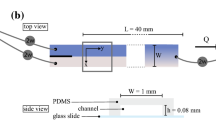Abstract
Two polymeric pseudostationary phases, one an acrylamide polymer and the second a siloxane polymer, have been investigated for the separation of naphthalene-2,3-dicarboxaldehyde (NDA)-derivatized amino acids and small peptides. The dervatized amino acids were detected by UV absorbance and laser-induced fluorescence (LIF) detection. The polymers provided very high efficiency and good selectivity for the separation of the amino acids. The separation selectivity using the polymers was significantly different from that of SDS micelles, and there were subtle differences in selectivities between the polymers. Although very good detection limits were obtained with LIF detection, a significant background signal was observed when the polymers were not washed to remove fluorescent impurities. The polymers did not separate the peptides very well. It is postulated that the fixed covalent structure of the polymers prevents them from interacting strongly or efficiently with the peptides, which are large in relation to the analytes typically separated by electrokinetic chromatography using polymers.




Similar content being viewed by others
References
Palmer CP (2000) Electrophoresis 21:4054–4072
Maichel B, Kenndler E (2000) Electrophoresis 21:3160–3173
Palmer CP (2002) Electrophoresis 23:3993–4004
Peric I, Kenndler E (2003) Electrophoresis 24:2924–2934
Palmer CP, McCarney JP (2004) J Chromatogr A 1044:159–176
Palmer CP, McCarney JP (2004) Electrophoresis 25:4086–4094
Smith JT (1999) Electrophoresis 20:3078–3083
Prata C, Bonnafous P, Fraysse N, Treilhou M, Poinsot V, Couderc F (2001) Electrophoresis 22:4129–4138
Poinsot V, Bayle C, Couderc F (2003) Electrophoresis 24:4047–4062
Kasicka V (1999) Electrophoresis 20:3084–3105
Kasicka V (2001) Electrophoresis 22:4139–4162
Kasicka V (2003) Electrophoresis 24:4013–4046
Peterson DS, Palmer CP (2001) Electrophoresis 22:1314–1321
Schulte S, Palmer CP (2003) Electrophoresis 24:978–983
Shi W, Peterson DS, Palmer CP (2001) J Chromatogr A 924:123–135
Shi W, Watson CJ, Palmer CP (2001) J Chromatogr A 905:281–290
Shi W, Palmer CP (2002) Electrophoresis 23:1285–1295
Author information
Authors and Affiliations
Corresponding author
Rights and permissions
About this article
Cite this article
Schulte, S., Singh, A.K., Rauk, E. et al. Performance and selectivity of polymeric pseudostationary phases for the electrokinetic separation of amino acid derivatives and peptides. Anal Bioanal Chem 382, 777–782 (2005). https://doi.org/10.1007/s00216-005-3131-6
Received:
Revised:
Accepted:
Published:
Issue Date:
DOI: https://doi.org/10.1007/s00216-005-3131-6




